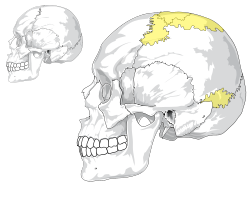
Wormian bones
Encyclopedia

Ossification
Ossification is the process of laying down new bone material by cells called osteoblasts. It is synonymous with bone tissue formation...
of the cranium and, although unusual, are not rare. They occur most frequently in the course of the lambdoid suture
Lambdoid suture
The lambdoid suture is a dense, fibrous connective tissue joint on the posterior aspect of the skull that connects the parietal and temporal bones with the occipital bone.Its name comes from its lambda-like shape....
, which is more "torturous" of a suture. They are also occasionally seen within the sagittal and coronal sutures. A large wormian bone at lambda is often referred to as an Inca bone (Os Incae), due to the relatively high frequency of occurrence in Peruvian mummies. Another specific wormian bone, the pterion
Pterion
The pterion is the point corresponding with the posterior end of the sphenoparietal suture.-Location:It is situated about 3 cm. behind, and a little above the level of the zygomatic process of the temporal bone.It marks the junction between four bones:...
ossicle, sometimes exists between the sphenoidal angle
Sphenoid bone
The sphenoid bone is an unpaired bone situated at the base of the skull in front of the temporal bone and basilar part of the occipital bone.The sphenoid bone is one of the seven bones that articulate to form the orbit...
of the parietal bone
Parietal bone
The parietal bones are bones in the human skull which, when joined together, form the sides and roof of the cranium. Each bone is roughly quadrilateral in form, and has two surfaces, four borders, and four angles. It is named from the Latin pariet-, wall....
and the great wing of the sphenoid bone
Sphenoid bone
The sphenoid bone is an unpaired bone situated at the base of the skull in front of the temporal bone and basilar part of the occipital bone.The sphenoid bone is one of the seven bones that articulate to form the orbit...
. They tend to vary in size and can be found on either side of the skull. Usually, not more than several are found in a single individual, but more than one hundred have been found in the skull of a hydrocephalic
Hydrocephalus
Hydrocephalus , also known as "water in the brain," is a medical condition in which there is an abnormal accumulation of cerebrospinal fluid in the ventricles, or cavities, of the brain. This may cause increased intracranial pressure inside the skull and progressive enlargement of the head,...
adult.
Wormian bones are a marker for various diseases and important in the primary diagnosis of Brittle Bone Disease osteogenesis imperfecta
Osteogenesis imperfecta
Osteogenesis imperfecta is a genetic bone disorder. People with OI are born with defective connective tissue, or without the ability to make it, usually because of a deficiency of Type-I collagen...
Wormian bones may also be seen in: Pyknodysostosis, Rickets, "Kinky-hair" Menke's syndrome, Cleidocranial dysositosis, Hypoparathyroidism and Hypophosphatasia, otopalatodigital syndrome, primary acro-osteolysis and Down syndrome.
Derivation of the name
Ole WormOle Worm
Ole Worm , who often went by the Latinized form of his name Olaus Wormius, was a Danish physician and antiquary.-Life:...
, Professor of Anatomy at Copenhagen, 1558–1654, He taught Latin, Greek, physics and medicine. Main contributions to science in embryology, Wormian bones of the skull have been named after him.

